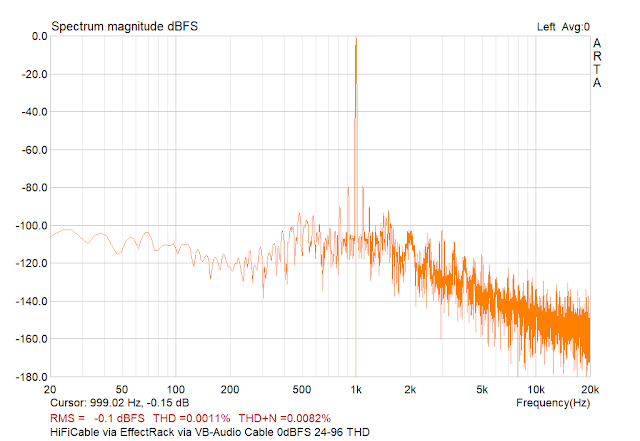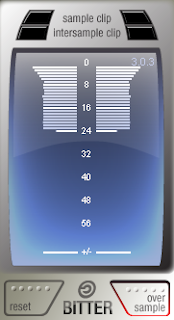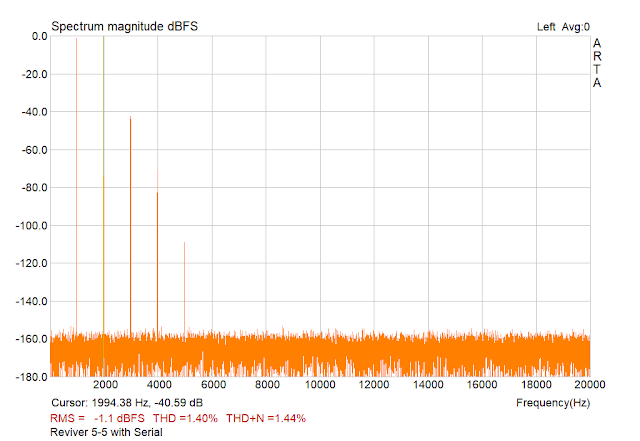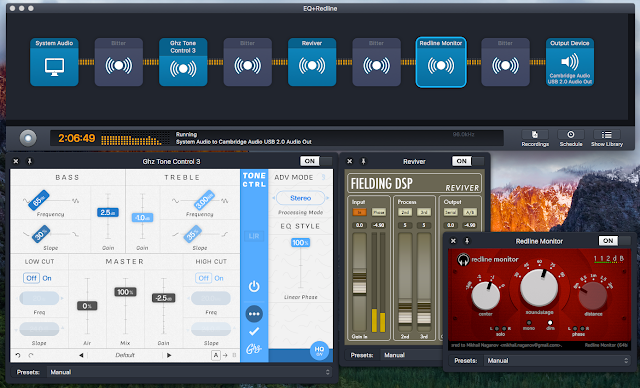Mikhail Naganov
My Setup for Headphone Listening, Part 2
Continuing the topic of my desktop setup for headphone listening, let’s recap what we had covered in Part 1. We have set up a transparent hardware chain at moderate cost, and decided to make all the necessary adjustments on the software side using DSP plugins. In order to route audio from any player program via the DSP processing chain, on Mac we use Audio Hijack, and on Windows—a combination of virtual loopback cables and a plugin host program. I’m not covering Linux and mobile platforms here, sorry.
The Processing Chain
I don’t believe in the existence of a perfect playback chain that would suit all commercial recordings. Even if the chain itself is transparent, the combination of recording’s frequency balance and the headphone’s frequency curve may not suit your taste. Also, due to non-linearity of human hearing, even changing playback volume affects perceived tonality. So clearly, an ability to tweak tonal balance is required.
Also, when using closed headphones the reproduction sounds unnatural due to super-stereo effect—each ear can hear its own channel only. This is especially noticeable on recordings that employ some form of “spatial” processing intended for speakers.
So our goals are pretty clear: being able to easily adjust levels of high and low frequencies, and have a crossfeed. In addition, we can try adding some psycho-acoustic enhancement by injecting 2nd or 3rd order harmonics (this is roughly equivalent to using a tube amplifier). Previously, I was also enthusiastic about the idea of headphone frequency response normalization. Now I’m less excited, and I will explain why later. But if headphones used are known to have some particular tonal issue, like the 6 kHz bump of Sennheiser HD800, adding a “normalizing” plugin could be a good idea.
So here is a conceptual diagram of the DSP chain I use:
First comes a simple 2- or 3-band equalizer employing Baxandall curves. I find these to be more pleasant sounding than typical shelving filters of multi-band parametric equalizers.
The next block adds harmonic distortions. It helps to liven up some recordings if they sound too dry and lack “dimension”. I think, in small controlled quantities harmonics sometimes can help. However, I prefer to add them with a DSP plugin rather than with an amplifier.
Then comes a crossfeed plugin. An alternative is to use the crossfeed feature of the headphone amplifier or DAC, if it has one. But using a plugin allows to have crossfeed on any DAC / amp, so it’s more versatile. Also, if crossfeed is implemented as a plugin, it’s possible to add a headphone “normalization” plugin after it. I think that having crossfeed after normalization defeats the purpose of the latter since crossfeed will most likely change the carefully tuned frequency response.
I run my chain at 96 kHz, even when the source material is at 44.1 kHz. Use of higher sampling rates is common in music production world, as they allow using smoother antialiasing filters during processing, and also help reducing the quantization noise. Going up to 192 kHz or higher will consume more CPU resources, and considering a modest amount of effects used, I don’t think it’s really needed.
At first, I was hesitating a bit whether should I use an integer multiple of the source sampling rate, that is, 88.2 kHz instead of 96 kHz, but then I realized that converting from 44.1 kHz to 48 kHz can be expressed conceptually as first upsampling with a multiplier of 160, and then downsampling by 147, both being integer multipliers (44100 * 160 / 147 = 48000). Also, a lot of good DAC units have an upsampling DSP processor connected before the DAC chip, for upsampling to 192 kHz (TEAC UD-x01), 384 kHz (Cambridge Audio DacMagic Plus and Azur), 768 kHz (!) (Pro-ject DacBox DS2 Ultra), or even an “odd” value of 110 kHz (Benchmark DAC1). So the DAC chip would never “know” what was the track’s original sampling rate.
Thus, there is no reason to worry about going from 44.1 kHz to 96 kHz on the processing chain side, as modern software resamplers should be transparent. This is assuming that the input signal doesn’t have intersample peaks. And we took care of this by lowering the digital volume of the player (see Part 1), giving some headroom to the audio signal before it gets upsampled.
Measurements
DSP plugins still need to be measured despite that their effects are usually better documented than of hardware units. Why? Because there can be surprises or discoveries, as we will see. Also, some plugins for some reasons have uncalibrated sliders, labelled in a very generic fashion like “0..10” and it’s not clear what changes each step introduces. So unless you have a very trained ear, it’s better to measure first.
And the audio transport channels that we use, despite being fully digital and thus supposedly “bit-perfect” still can introduce distortions, or cause losses in audio resolution. This is an imperfect world, and we need to be prepared.
The Empty Chain
As an example, let’s measure an empty processing chain consisting of Windows 10 Pro (Build 17134.rs4_release.180410-1804), Hi-Fi Virtual Cable (from player to the effects host), VB-Audio Cable (from the effects host to the analyzer input), and DDMF EffectRack (64-bit version). The virtual stream on the EffectRack uses “Windows Audio Exclusive mode”.
One problem that I’ve noticed is that using a test sine signal at 0 dBFS causes distortion:
But after lowering the input signal level by just 0.1 dB it’s gone. I’ve double checked that the test signal is not overshooting 0 dBFS. I’ve also checked with Bitter plugin that the signal is not clipping:
Having that a lot of modern recordings have peaks normalized to 0 dBFS the advice I gave in Part 1 about lowering the digital volume on the player by at least 3.5 dBFS seems especially useful in this case.
I’m not sure where this distortion is happening—it could be anywhere in the kernel audio transport, in virtual cables, or in EffectRack. However, I’ve also tried this experiment with DDMF virtual streams, and with another effects host: PedalBoard 2, and the result was the same, so I’m suspecting Windows audio chain. But I must note that 0 dBFS sine plays fine via lots of sound cards’ physical loopback, thus most likely it’s a combination of Windows and virtual cable drivers that causes this behavior.
The lesson from this measurement is that I should not use a 0 dBFS test signal when testing the processing chain.
Another curious thing I’ve found is that with some virtual cables EffectRack causes distortion when there are no effects in the chain (stream’s audio input is directly shorted to audio output), but the distortion is gone as soon as I insert a processing plugin, even if it does nothing to the audio stream (all processing knobs are at zero position).
By the way, using Bitter plugin is also helpful for verifying the actual bit resoluton of the processing chain. As we have seen on the screenshot above, on Windows I do actually have 24-bit resolution. It’s interesting that on Mac with Audio Hijack the resolution seems to be even better—32-bit:
The Equalizer
There is no shortage of equalizer plugins. My long time favorite was basiQ by Kuassa because it’s free, simple to use, and it implements a good old 3-band Baxandall equalizer. Typically I used it in very moderate amounts never going more than 5 or 6 steps from the zero settings. This is how the equalization curves look like:
Note that even in “all zeroes” setting the frequency response isn’t entirely flat. I’m not sure if it’s intentional, but it’s better to be aware of this (that’s why we measure!) Also note that the amount of correction resulting from the same amount of knob steps are not the same for low, mid, and high frequencies. I think, this is to account for the fact that human ear is less sensitive to changes in bass frequencies.
Another important thing is that when boosting any frequencies, the resulting increase in the sound power must be compensated by decreasing the output level of the plugin (the small knob at the bottom), otherwise clipping may occur on loud music passages.
But I’ve said that basiQ used to be my favorite plugin. I’ve migrated to Tone Control by GoodHertz, and this is why. Although it only has 2 bands (vs 3 on basiQ), Tone Control has an interesting offering of using a linear phase filter. That means zero group delay—no frequency groups get delayed by processing. This is important because some musical sounds (e.g. a hi-hat crash) are wide band signals, and delaying some parts of this signal “smears” the sound in time domain, which according to some theories affects its localization by brain.
Tone Control isn’t free, and actually it’s quite expensive for a 2-band equalizer ($95!). However, using it I could easily replicate my setups in basiQ, and Tone Control can create web shortcuts for them to use anywhere. Before that I tried DDMF LP10 equalizer, which also offers linear phase filters, but replicating delicate tone curves of basiQ with it was very hard, so I decided to pay a bit more for Tone Control.
Harmonics Enhacement
I decided to experiment with adding harmonics after reading this post by Bob Katz. I’ve found Fielding DSP Reviver plugin, which costs just $29. I measured it in order to calibrate the scales of its controls—they just go from “0” to “100”, and also to verify that they don’t have aliasing problems.
After measuring the levels of THD of Reviver, I decided never to go higher than “5” mark for both 2nd and 3rd harmonics. For the reference, the “1” mark adds 2nd harmonic at ~0.2% THD (about -55 dBFS), and for “5” it’s a bit higher than 1% THD (about -40 dBFS). And for the 3rd harmonic the figures are a somewhat lower, so when both sliders are at “5”, this creates a natural harmonics picture:
(I’ve put the cursor over the 2nd harmonic to show that it’s at -39.95 dBFS, while the 3rd as we can see is lower than -40 dBFS.)
Turning on “Serial” mode also adds 4th and 5th harmonics:
Subjectively, adding harmonics may add “dimension” to sound, make it a bit “fatter”. It in facts helps some recordings from 70-s and 80-s to sound better. My hypothesis is that for their production, tube amplifiers were be used in studio, so they were sounding “rich” there. But while being played via a transparent solid state chain on headphones they sound more “bleak” and “flat”. So adding back some distortions helps.
However, I would not recommend abusing the harmonics plugin because, unfortunately, adding those “euphonic” harmonic distortions also brings in unpleasant non-harmonics. Dr. Uli Brüggemann of AudioVero explains the reasons in his article. And indeed, if we look at IMD SMTPE and CCIF measurements for Reviver, the level of SMTPE-measured distortions is quite high. So use it with caution—keeping it turned on all the time defeats the purpose of having a transparent reproduction chain. The effect of non-linear distortions can also be seen on the frequency response graph which becomes noticeably “fuzzier”:
Crossfeed and Headphone Normalization
I covered both Redline Monitor and a couple of headphone normalization plugins in my earlier posts. For headphone normalization I would also prefer a plugin that has “linear phase” mode.
Now I would like to explain why I’m actually not currently using headphone normalization. From my experience, normalization indeed makes the headphones sound different from their original tuning, which can be exciting at first. But is it really a setup that you would want to use all the time? I doubt that. I actually have doubts that normalization can serve as a “reference”, here is why.
There are several factors that can affect the headphone normalization process: first, the same model of headphones isn’t necessarily consistent from instance to instance, and besides that, pad wear can affect bass response. OK, some companies offer measuring your headphones, and imagine we have done that. Then the second factor comes in—your head. The dummy heads used in measurement use statistical averages for head, ear pinna, and ear canal dimensions. But they are obviously not the same as your head, and this will affect the shape of the frequency response at the ear drum (see this interesting thesis work for details). And finally, the target response is not set in stone. There are several versions of Harman target curve, diffuse field curve, and your actual room curve.
So, there are just a lot of variables in the normalization process. There is a solution that takes them all into account—the Smyth Realizer, but it’s too expensive for an ordinary folk. Thus, since we are not interested in music production, but only in pleasantly sounding reproduction, I’ve found that simply using tone controls delivers a desired sound with much less effort.
Conclusion
For me, using a simple DSP processing chain and a transparent reproduction chain has become a flexible and not too expensive way to enjoy my music in headphones. This setup offers endless ways to experiment with tonalities, “warmth”, and soundstage perception while staying with the same hardware.









